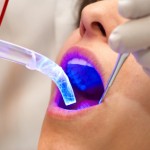
Oral lichen planus (OLP) is a common, chronic, inflammatory, mucocutaneous disorder associated with cell-mediated immune system dysfunction. It affects between 0.5 – 2% of the population, typically adults over the age of 30 with a female predication. A number of clinical forms are recognised, reticula, papular, plaque like, erosive, atrophic and bullous. Treatment is mainly focused are on symptoms alleviation and elimination of mucosal erythema and ulcerations. Topical and systemic steroids are the most commonly used treatments. Photodynamic therapy (PDT) which involves topical or systemic administration of photosensitive drugs followed by light irradiation using specific wavelengths is emerging as a potential treatment.
The aim of this review is to evaluate the effectiveness of PDT in the management of symptomatic OLP.
Methods
Searches were conducted in the Medline/PubMed, Scopus and ISI web of Knowledge databases.
Randomised controlled trials (RCT), non-RCT and controlled or comparative clinical studies in adults over 18 and published in English were considered. To independence reviewers selected studies assessed quality and abstracted data. Study quality was assessed using the CONSORT statement. A narrative summary of the findings was presented.
Results
- 5 studies (3RCTs, 2 non-RCT) involving a total of 91 patients were included.
- 2 studies were conducted in Egypt, 2 in Iran and 1 in India.
- All 5 studies included atrophic-erosive OLP with no histological signs of dysplasia.
- 2 studies used are diode laser, 3 studies used light emitting diode are(LED).
- Light wavelengths used ranged from 420 two 660 nm.
- All 5 studies reported PDT to be effective.
- 4 studies were considered to be at high risk of bias, 1 at moderate risk.
Conclusions
The authors concluded: –
The limited available evidence suggests that PDT is an effective treatment option for the management of OLP. However, due to the limited number of studies included in this review and heterogeneity among these studies, more well-designed clinical trials with adequate sample sizes are highly warranted.
Comments
This review has searched 3 major databases for studies to address this question although restricting the language to English may have excluded some studies. While the studies demonstrated a benefit with PDT the sample sizes were small and follow-up short. The majority of the studies included were also at high risk of bias. So, while this review suggests that this treatment may offer some potential for the management of OLP larger well designed and reported studies with the longer follow-up period are needed to properly determine effectiveness. Previously we have considered a review of low level laser therapy for the management of OLP and that also suggests that some benefit but as with PDT further high-quality trials are required.
Links
Primary Paper
Al-Maweri SA, Ashraf S, Kalakonda B, Halboub E, Petro W, AlAizari NA. Efficacy of photodynamic therapy in the treatment of symptomatic oral lichen planus: A systematic review. J Oral Pathol Med. 2018 Jan 19. doi: 10.1111/jop.12684. [Epub ahead of print] Review. PubMed PMID: 29350426.
Other references
Original review protocol in PROSPERO
Dental Elf – 22nd Nov 2017
